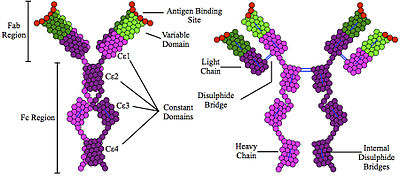ഇമ്മ്യൂണോഗ്ലോബുലിൻ ഇ
സസ്തനികളിൽ മാത്രം കണ്ടെത്തിയിട്ടുള്ള ഒരു ആന്റിബോഡിയാണ് (അല്ലെങ്കിൽ ഇമ്യൂണോഗ്ലോബുലിൻ (ഐജി) " ഐസോടൈപ്പ് ") ഇമ്മ്യൂണോഗ്ലോബുലിൻ ഇ ( ഐജിഇ ). പ്ലാസ്മ കോശങ്ങളാണ് ഐജിഇയെ ഉത്പാദിപ്പിക്കുന്നത്. ഐജിഇയുടെ മോണോമറുകളിൽ രണ്ട് ഖനശൃംഖലകളും (ε ശൃംഖല) രണ്ട് ലഘുശൃംഖലകളുമാണ് അടങ്ങിയിരിക്കുന്നത്. ε ശൃംഖലയിൽ ആന്റിബോഡി പോലുള്ള 4 കോൺസ്റ്റന്റ് ഡൊമൈനുകൾ (Cε1-Cε4) അടങ്ങിയിരിക്കുന്നു. [1] സ്കിസ്റ്റോസോമ മൻസോണി, ട്രിച്ചിനെല്ല സ്പൈറാലിസ്, [2] [3], ഫാസിയോള ഹെപ്പാറ്റിക്ക എന്നിവയുൾപ്പെടെ ചില പരാന്നഭോജികളായ ജീവികൾ മൂലമുള്ള അണുബാധയ്ക്കെതിരായ ശരീരത്തിന്റെ രോഗപ്രതിരോധ പ്രതികരണത്തിൽ ഐജിഇ പ്രധാന പങ്കുവഹിക്കുന്നു എന്നാണ് കരുതപ്പെടുന്നത്. [4] പ്ലാസ്മോഡിയം ഫാൽസിപ്പാറം പോലുള്ള ചില പ്രോട്ടോസോവൻ പരാദങ്ങൾക്കെതിരായുമുള്ള ശരീരത്തിന്റെ പ്രതിരോധത്തിലും ഐജിഇ ഭാഗഭാക്കാകുന്നുണ്ട്. [5] വിഷപദാർഥങ്ങളിൽ നിന്ന് ശരീരത്തെ സംരക്ഷിക്കുന്നതിനുള്ള ഒരു പ്രതിരോധമായി ഐജിഇ പരിണമിച്ചിരിക്കാം. [6] [7] [8]


കണ്ടെത്തൽ
തിരുത്തുകഐജിഇയെരണ്ട് സ്വതന്ത്ര സംഘങ്ങൾ 1966ലും 1967ലുമായി ഒരേസമയമാണ് കണ്ടെത്തിയത്. [9] കിമിഷിഗെ ഇഷിസാക്കയും ഭാര്യയായ തെരുകൊ ഇഷിസാക്കയും കൊളറാഡോയിലെ ഡെൻവറിലുള്ള ചിൽഡ്രൻസ് ആസ്ത്മ റിസർച്ച് ഇൻസ്റ്റിറ്റ്യൂട്ട് ആന്റ് ഹോസ്പിറ്റലിൽ വെച്ചും [10] സ്വീഡനിലെ ഉപ്സാലയിൽ വെച്ച് എസ്. ജി. ഒ. ജൊഹാൻസണും ഹാൻസ് ബെന്നിച്ചും (എസ് വി) . [11] അവരുടെ സംയുക്ത പ്രബന്ധം 1969 ഏപ്രിലിൽ പ്രസിദ്ധീകരിച്ചു. [12]
അവലംബം
തിരുത്തുക
- ↑ "Antibody structure". Archived from the original on September 6, 2008.
- ↑ "Helminths, allergic disorders and IgE-mediated immune responses: where do we stand?". European Journal of Immunology. 37 (5): 1170–3. May 2007. doi:10.1002/eji.200737314. PMID 17447233.
- ↑ "IgE: a question of protective immunity in Trichinella spiralis infection". Trends in Parasitology. 21 (4): 175–8. April 2005. doi:10.1016/j.pt.2005.02.010. PMID 15780839.
- ↑ "IgE production in rat fascioliasis". Parasite Immunology. 5 (6): 587–93. November 1983. doi:10.1111/j.1365-3024.1983.tb00775.x. PMID 6657297.
- ↑ "Total and functional parasite specific IgE responses in Plasmodium falciparum-infected patients exhibiting different clinical status". Malaria Journal. 6: 1. January 2007. doi:10.1186/1475-2875-6-1. PMC 1781948. PMID 17204149.
{{cite journal}}: Invalid|display-authors=6(help)CS1 maint: unflagged free DOI (link) - ↑ "The function of allergy: immunological defense against toxins". The Quarterly Review of Biology. 66 (1): 23–62. March 1991. doi:10.1086/417049. PMID 2052671.
- ↑ "Allergic host defences". Nature. 484 (7395): 465–72. April 2012. Bibcode:2012Natur.484..465P. doi:10.1038/nature11047. PMC 3596087. PMID 22538607.
- ↑ "A beneficial role for immunoglobulin E in host defense against honeybee venom". Immunity (in ഇംഗ്ലീഷ്). 39 (5): 963–75. November 2013. doi:10.1016/j.immuni.2013.10.005. PMC 4164235. PMID 24210352.
{{cite journal}}: Invalid|display-authors=6(help) - ↑ "The discovery of IgE". Allergy. 48 (2): 67–71. February 1993. doi:10.1111/j.1398-9995.1993.tb00687.x. PMID 8457034.
- ↑ "Physico-chemical properties of human reaginic antibody. IV. Presence of a unique immunoglobulin as a carrier of reaginic activity". Journal of Immunology. 97 (1): 75–85. July 1966. PMID 4162440.
- ↑ "Immunological studies of an atypical (myeloma) immunoglobulin". Immunology. 13 (4): 381–94. October 1967. PMC 1409218. PMID 4168094.
- ↑ "Histamine release from human leukocytes by anti-gamma E antibodies". Journal of Immunology. 102 (4): 884–92. April 1969. PMID 4181251. Retrieved 2016-02-29.